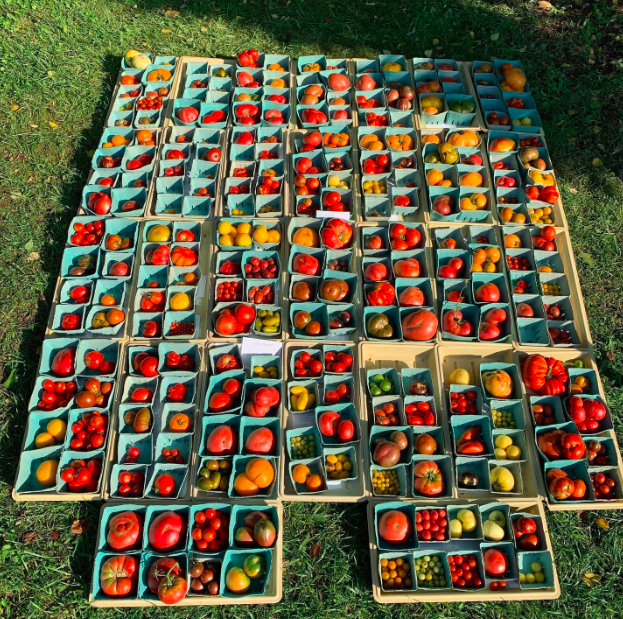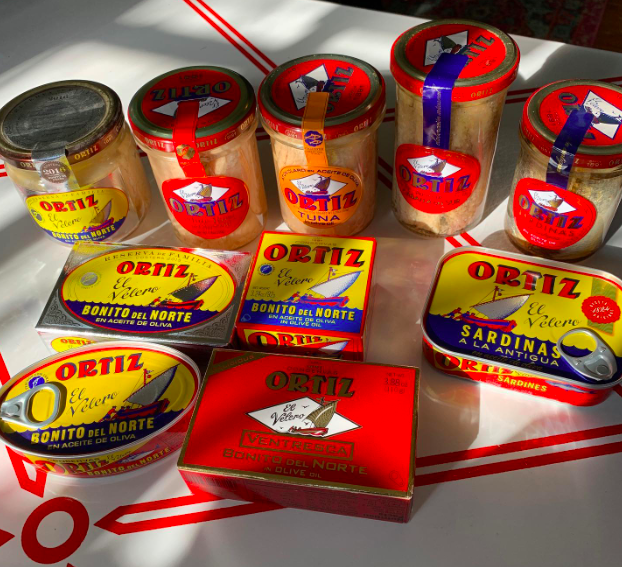Tomatoes and Tinned Fish: Rainbow Tomatoes Garden Farm Stand

Welcome to market share, a newsletter about where we get our groceries. Every week or so, we highlight innovative markets, bodegas, corner stores and more — and the people who run them. To kick off the series, I wanted to start by chatting with Dan Waber, a farmer in East Greenville, Pennsylvania, whose stand specializes in two things: tomatoes and tinned fish.
To hear Dan Waber tell it, starting a farm stand was almost inevitable.
Inspired by Michael Pollan’s “The Omnivore’s Dilemma” and a health-based desire to lose over 100 pounds, he bought property to grow his own food after determining he needed to remove himself from the industrial food system.
“We spent a year getting the land ready and learning about what it might want to produce for us,” Waber said. “This is our retirement plan, so the goal was never to get as big as possible. It was always to live the best life possible, which means low volume and high margin rather than high volume and low margin.”
He added: “The property is on a busy road, the barn already had an overhang, so selling retail as a farm stand made sense.”
As for what the land wanted to produce, the answer was pretty apparent: Tomatoes. 320 different kinds. Plump Pink Furry Boars, with their rosy-colored skin and creamy stripes. Glossy and golden Old Ivory Eggs. Stunning Riccio Di Parma tomatoes, with their bulbous, ruby red “pleated” flesh that looks like something out of a Dr. Seuss book. Every morning during that first season in 2020, Waber would set out a kaleidoscopic array of tomatoes, ranging from the palest yellow to almost-black varieties, at the Rainbow Tomatoes Garden farm stand.
But then, the weather began to turn.
“When the tomatoes stopped coming in, we realized two things: we had no plan for what would happen after the tomatoes — we were too busy figuring out how to do the tomatoes,” Waber said. “And people kept coming to the stand saying, ‘Well, what else do you have?’”
So, they started sourcing things that went with the tomatoes. People would often leave the stand joking that all they needed was some salt —— so Waber brought in some lovely flaky salts like Esprit du Sel Île de Ré Grey Sea Salt with Organic Fennel, Garlic, and Parsley and Jacobsen Sel Gris. Occasionally, he would overhear customers arguing about which mayonnaise was the best for tomato sandwiches. “And I'd always chime in with ‘Japanese-made Kewpie,’ which is the truth, so I started bringing it in,” he said.
They completed the meal with home baked goods made by Waber’s daughter, Helen, a trained pastry chef.
“Then I thought, I don't know if anyone will want to buy tinned fish from a farm stand, but, ventresca (the belly of the tuna) is traditionally served with tomatoes, and a mackerel, lettuce, and tomato sandwich is wicked good, so, let's see,” Waber said.
He started with one order for a case each of a few different kinds of each — and they sold out on the first day.
“I replaced those and added another few types,” he said. “They sold out in a few days. And I just kept doing that, promising that I'd stop broadening the line when people stopped buying, and they never stopped.”
They are now up to 467 different varieties of tinned seafood.
“We don't offer everything that's available, it's actually a pretty highly curated selection,” he said. “We only sell the things we like enough to recommend. We found that the kind of customer interested in 320 different kinds of tomatoes is interested in the variety of flavor experiences available in all sorts of different products, not just tomatoes.”

Tinned fish consumption in the United States has changed a lot over the last century. Americans used to be super into tinned herring, oyster, salmon and sardines — to the point that, as Waber put it, there used to be arguments “a la PC versus Mac or Pepsi versus Coke” over which sardines were better between California or Maine varieties. That all started to change in the 40s and 50s when, as a culture, we “began to see any tinned fish that wasn’t tuna as ‘gross’ in ways that most people are aware of but find difficult to articulate.”
“No one I've talked to knows why,” Waber said “I have a theory, but nothing to back it up other than anecdotal evidence.”
That said, tinned fish are undeniably part of the zeitgeist right now. They are, after all, “the ultimate hot girl food.” A large part of their resurrection in recent years has been due to the pandemic-era fixation on pantry staples and the inevitable desire to elevate those items (I’m still lusting over a Rancho Gordo Bean Club subscription, for what it’s worth). Waber thinks it goes deeper, though.
“The pandemic got a lot of people searching for new food experiences, especially ones that could make them feel transported to another place —many people talk to me about first tasting quality tinned seafood on a trip to Spain or Portugal or France or Japan,” he said. “Or another time; many people talk to me about sharing sardines on the lap of a grandparent, and found me while trying to reconnect with those memories.”
As such, Waber doesn’t think that the embrace of tinned fish is fleeting.
“I think what we're experiencing is an expansion in awareness that a range of delicious products exists which is vast enough to be exciting to explore,” he said. “I see tinned fish like craft beer. At one point people were writing articles about ‘the summer of craft beer,’ and it wouldn't surprise me if you could find that someone once declared that craft beer is ‘the hot girl beverage.’”
Now, you can’t hardly go into any restaurant or store that doesn’t have a respectable selection of craft beers. Tinned fish, Waber said, is “smart people food;” it’s preserving the best from a seasonal harvest so that it can be enjoyed out of season, and in many cases improved by the process.
***
When I ask Waber what products he’s most excited about right now, he gives a simple answer: “Pretty much everything.”
“One benefit of being as small as we are is that we don't do anything we're not excited about,” he said. “People aren't coming here because they want the same thing they can get everywhere else, they're coming here to get what we're excited about.”
One of the metrics employed by Waber and his family when it comes to purchasing for the farm stand is asking the question, “What if nobody buys this? Are we okay if we get stuck with it and have to eat it ourselves?" If the answer is, "Yes!" then they add it. If the answer is "No." they don't.
That said, Waber did pick a few things that are especially exciting from a few different categories:
Tomatoes
The first two years we grew 320 different kinds of tomatoes, and started them all from seed. Every variety we chose was on someone's list of best tasting tomatoes. Last year when we went to plant out the seedlings which we'd started indoors under lights and gradually hardened off outside, we noticed thousands and thousands of volunteer plants in the field. These were seeds from tomatoes that had fallen in the field the season previous. Maybe they were named cultivars (tomatoes do self-pollinate, but they are also prolific outcrossers, which means if a bee does go from one plant to another they will readily cross), maybe they weren't, there was literally no way to know. But, as a family, we found that we really developed an affection for these plants. They were hardy, hardier than the pamper-loins that had been carefully protected indoors. They wanted to live. And so we let a lot of them live, and they made great tomatoes. We called these unknown tomatoes "Curious" and charged the same price, because we found that while many people wanted and needed to know the names of the tomatoes, just as many (or more) liked knowing the names, but really just wanted great tasting tomatoes no matter if they were named or not. So this year we're only starting 60 varieties from seed and we're going to make up the balance of the variety (same 1000 total plants) with the volunteers. We'll interplant the named varieties with the volunteers (every year) to ensure enough genetic diversity that we don't devolve into one kind.
Baked goods
Helen is always coming up with new things for the baked goods offerings. She's recently started making savory stuffed bread bombs, which are basically bread balls with caramelized onion, potato, chive, and bleu cheese on the inside — they're perfect for people who stop in the stand to get a tin of fish for lunch. And on the sweet side, this morning she made a pan of mocha marshmallow-topped brownies that are stunningly good. (She made the mocha marshmallows, too, by the way.)
Tinned fish
The tin of fish I'm most excited about at the moment is probably the Codesa Serie Oro anchovy fillets. It's the second-best anchovy produced by the company that makes the anchovy ranked #1 on the Anchovy list and #5 on the Overall list at worldbestfish.com. And just an impeccable product. Almost ham-like. Good enough to be eaten on their own on slices of the best bread you can obtain drizzled with the tin oil and a favorite cheese. Many tinned fish products show only marginal differences between producers at the highest levels of quality, but occasionally a product comes along that is just clearly head and shoulders above the rest. This is one such product.
Performances
And the season's schedule for The Wunderbarn has just been finalized and announced, and there's a lot of things I'm excited about, but what I love most are the Only and Hour Variety Hour and Open Mic which we have every Third Friday, weather permitting. Anything can happen, and usually does. In addition to music and poetry we often see movement artists, clowns, jugglers, comedians, and storytellers. There's so much talent in every local community, and we are continuously amazed by the things we learn about the people we think we know. Open mics are like public libraries, public baths and community gardens.
***
Interested in shopping at Rainbow Tomatoes Garden Farm Stand? Be sure to check out their website here. Have a grocery you'd like to see featured? Drop me a line at ashliedaniellestevens (@) gmail (dot) com.